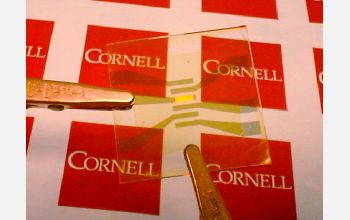Multimedia Gallery
Ruthenium Bipyridine Wafer
A pair of tweezers holds a ruthenium bipyridine wafer. The wafer will serve as the base for six efficient, single layer, solid-state light-emitting devices (one of the devices is lit). These devices are being developed for applications in flat panel displays and lighting.
Work in the Malliaras Group (device fabrication and studies) was funded by National Science Foundation Faculty Early Career Development (CAREER) Program (award DMR 00-94047). The synthesis of the materials took place in the Abruna Group and was funded by the Cornell Center for Materials Research (CCMR), an NSF Materials Research Science and Engineering Center (MRSEC) (grant DMR 96-32275). [One of 14 related images. See Next Image.]
More about this Image
Once the target of solely experimental research, the electronic and photonic components that are crafted from organic chemicals now drive major markets. Uses for the scalable, light weight technologies range from the billion dollar photo-conductive film industry to the growing market for solid-state lighting, such as LEDs (light-emitting diodes).
Organic electronic and photonic applications that are still in development may have an even broader impact, serving as flexible electronics, biologically-compatible devices, solid-state lighting and chemical sensors, as well as devices yet to be conceived.
In January 2003, an NSF-sponsored workshop took place in which experts from industry and universities came together to discuss the future of the field. Some of the highlights discussed by participants were new developments, changing directions in research and the needs facing investigators as they train the next generation of engineers.
For further information, see NSF Media Advisory PA/M 03-03. (Year of image: 2002)
Credit: The Malliaras Group, Cornell University; National Science Foundation
Images and other media in the National Science Foundation Multimedia Gallery are available for use in print and electronic material by NSF employees, members of the media, university staff, teachers and the general public. All media in the gallery are intended for personal, educational and nonprofit/non-commercial use only.
Images credited to the National Science Foundation, a federal agency, are in the public domain. The images were created by employees of the United States Government as part of their official duties or prepared by contractors as "works for hire" for NSF. You may freely use NSF-credited images and, at your discretion, credit NSF with a "Courtesy: National Science Foundation" notation.
Additional information about general usage can be found in Conditions.
Also Available:
Download the high-resolution TIFF version of the image. (494 KB)
Use your mouse to right-click (Mac users may need to Ctrl-click) the link above and choose the option that will save the file or target to your computer.



